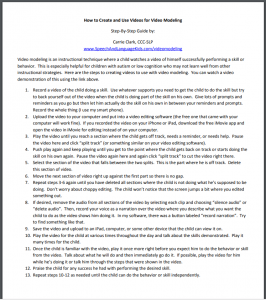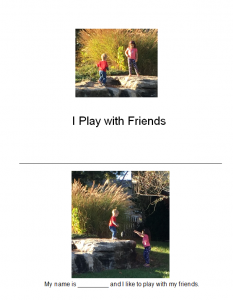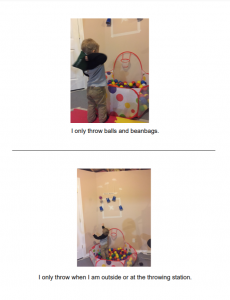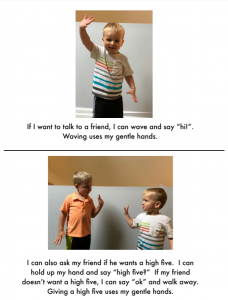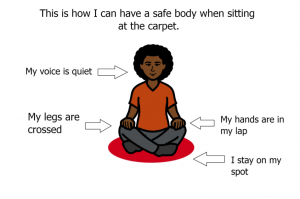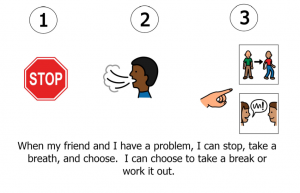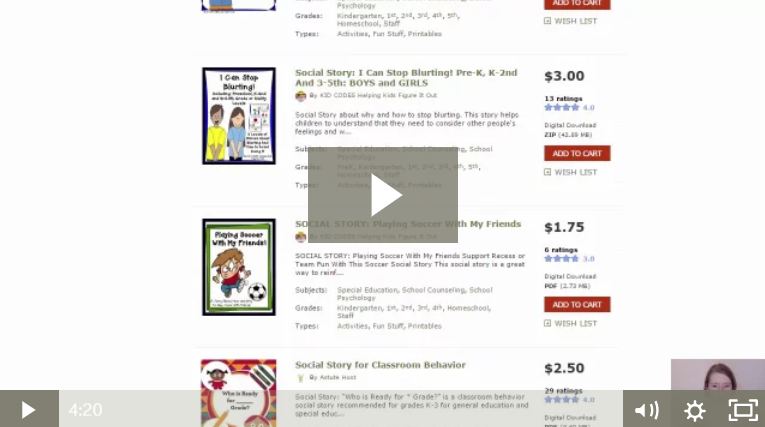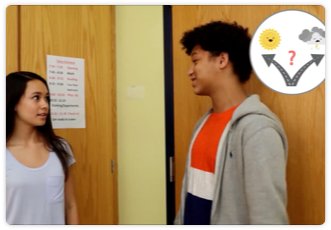Approach: Social Stories & Video Modeling
Description:
Overview:
This video will give you a quick overview of a what a social story is, when to use them, and how to use them:
Therapy Phases:
- Identify a Behavior to Teach: The SLP will identify a behavior to teach that will either reduce the use of maladaptive behaviors or support the child socially.
- Take pictures of the child doing those behaviors: The SLP will stage photos of the child doing the expected behavior.
- Put the pictures together in a book: The SLP will use positive “I” statements to write a story about the expected behavior.
- Read the book and act it out: Client will attend to a social story being read about expected behavior. Client will then participate in a role-playing scenario to practice the expected behavior.
- Refer to the Book for “Re-Dos” in Natural Environment: After situations where the expected behavior should have occurred but did not, Client will participate in a “re-do” with an adult by referencing the social story for the expected behavior and role-playing the expected behavior in the specific situation that occurred.
- Generalization of Skill to Other Environments: Client will follow adult prompts and cues to use the expected behavior in a variety of environments.
Activities:
Now it’s time for some in-depth information about how to conduct each of these therapy phases. Click on a therapy phase to learn more.
First, we start with a behavior. To be honest, we usually start with a behavior that we DON’T want to see. Those usually come to our attention first. Though it may just be a behavior that we would like to see the child exhibit that he is not, like initiating interactions.
Whatever the situation that makes you think, “we need a social story”, you’ll want to start with the idea of what DO you want the child to do? If you start with a behavior you don’t want to see, like hitting, think about what you want to see instead. For this, you’ll need to do a little informal functional behavioral analysis to figure out what the function of the behavior is. If the child is hitting, is he doing so to protest? Or get attention? The 5 functions of behavior are as follow:
- To gain attention (from peers or adults)
- To get something (like a toy or treat)
- To avoid something (like an activity that’s coming up)
- To escape something (like an activity that’s already happening)
- For sensory input or because the behavior itself is self-rewarding (it feels good, makes the child happy)
Once you identify what the function is, you can identify a different way for the child to get that need met. Focus on ways that use good, positive communication. For example, if the child is using behaviors to escape, teach the child to use language to ask for a break. If the child is non-verbal, use a form of AAC like handing an adult a break card or signing “break”.
Identify the behavior that you want to see and the contexts in which you would like to see it. Work together with your behavioral therapists, OTs, PTs, teachers, parents, and anyone else who may be a part of the situation.
Think through the social story that you’ll be writing for the child. It will likely say something along the lines of “when this happens, I do this”. Think about all of the different contexts in which you would like the child to exhibit that behavior. You can start by thinking about the times that he does the maladaptive behavior, but make sure you flip it to the positive spin.
Take pictures of the child doing the expected behavior in those situations. You’ll probably have to stage these and you may have to force it a little. For example, if you’re trying to get a child to say “hi” to a friend instead of smacking him upside the head, you will want to take a picture of the child in front of another child. Put the two children together and take a bunch of pictures. Choose the one that looks most like he was saying hi to him, even if you know that’s not really what he was doing.
Take pictures in as many of the contexts as you can. If you really can’t get pictures of the child, you can always use stock photos or clip art. Google image search is one of my favorite tools for this. But keep in mind it won’t be as effective as if the child sees himself in the photos. I’ve actually seen a teacher photoshop the child’s face onto a stock photo of a different child doing the expected behavior. The child thought that was pretty great!
Modification for Video Modeling:
If you’re using video modeling instead of a social story, you’ll want to record videos instead of take pictures. Go ahead and provide the client with as many prompts as needed to complete the skill successfully. You’ll edit out the prompts later so it looks like he/she did the skill independently. Keep in mind you may have to stage these situations to make them look successful.
Now it’s time to make the book! I like to start my books off with a nice statement like, “My name is ____ and I can ____.” This introduces the topic and helps the child identify himself in the story. Then, I move right into the expected behavior. You’ll want to write about the trigger or situation and the expected behavior. For example, you could say “When I want to play with a friend, I can say ‘hi'”. Try to keep only a few sentences on each page and represent each incidence of the expected behavior with a picture. You can add speech bubbles to represent the words you want the child to say.
Put together as many pages and pictures as you need to completely convey the point to the child. Some skills may have several examples or steps, such as describing the appropriate body language for a conversation (make eye contact, appropriate distance away, etc.). Other skills may be simpler and not require as many pages.
Here are a few examples of social stories to get you going. You can find other pre-made stories across the internet, but keep in mind that it will always be more effective for the child to see himself. And they don’t take long to make once you get the hang of it!
Social Story Examples:
- How to Initiate Play (for Verbal Children): The maladaptive behavior was hitting to gain peer’s attention so the expected behavior was asking a friend to play in a variety of ways (the child was quite verbal)
- Throwing for Sensory Input: The maladaptive behavior was throwing toys for the function of sensory input so the new expected behavior was to ask to use the throwing station when he needed that input.
- Initiating Interactions for a Minimally Verbal Child: Maladaptive behavior was hitting to gain peer attention but the child didn’t have many words yet so the expected behaviors were ways to initiate play using shorter utterances and interactions at a much younger level.
- Other Sources for Pre-Made Social Stories
If you are creating a video, you’ll want to edit down the video footage that you took so it looks like the child completed the task without your prompts. You can do this in any simple video editing program, such as iMovie. Then, you can add a voice-over that describes what the child is supposed to do in positive “I” statements (such as, “If I want to play with a friend, I walk up close…”).
Here’s an example to show you what I mean. One of the classrooms I worked in had one little boy who was struggling to make it from the door of the school to his classroom and hang up his backpack. He would get side-tracked, wander into other classrooms, and lay down on the floor. One of the teachers took a video of him coming into the school. Each time he would get off track, a different teacher would step in and put him back on the spot where he wandered and point him in the right direction. Then the second teacher would step back and he would take a few more steps before he wandered again. It took forever to get him to his classroom that first day but the first teacher videoed the entire process. Then, the teacher edited out every time that the second teacher stepped in to help. The end result was a video of him walking from the front door to his classroom with no help. Sure, it was a little jerky where the cuts were made, but he LOVED it! He watched himself being successful over and over again. The next day, he knew exactly what he was supposed to do and was much more successful than before the video.
Print out your story and read it with the child. Point out the child in the pictures and have the child practice saying the words or using the communication strategies as you’re reading. Or, watch the video and comment about how successful the child has completed the skill. Praise the child with specific language of what he did correctly. Then, role play the situations and act them out with the child. Talk about how the child can use those behaviors throughout his day.
Make sure that the child is reminded of the expected behaviors before he gets into those situations. You can do this by having the teacher/parent read the social story (or watch the video) with the child before the time when he most needs it (like before free play for social skills). Then, when the child misses an opportunity to use the expected behavior (such as when he uses the old maladaptive behavior instead), initiate a re-do. You can do this if you’re around or have the teacher/parent do it if you’re not.
Take the child aside and refer to the social story. Say, “I saw ____ happen but you forgot to do ___”. Show the child the part of the book or video that describes the appropriate behavior and talk to the child about how he could have done that thing. If there are choices in the book/video, such as multiple options of how to initiate with a peer, let the child choose which one he would like to practice. Then, go back and re-do the situation. Try to make your re-do as similar to the original incident as possible. Bring in the people who were involved. Or, if that’s not feasible, the adult can stand in as that person instead. Have the child act out the behavior he should have used. Give feedback and positive reinforcement for using the expected behavior.
BONUS TIP: Positive Intent
When the child forgets to use the new behavior, it is always helpful to use the power of positive intent. Instead of just pointing out that the child did something wrong, start by attributing positive intent to the child. Think about a way that you can describe that the child intended to do something positive and that’s why the old behavior happened, not because the child was trying to be naughty. For example, if your client runs up and knocks down a friend, you could attribute positive intent by saying “You were excited about seeing your friend! You wanted to play with him.” Then, you can go on to describing what the child could do instead. It might sound something like this:
- Client knocks down a friend
- “You were excited about seeing your friend! You wanted to play. But you may not knock friends down. That hurts our friends. If you want to play, you can say “Let’s play.” Let’s go look at our book and we can have a re-do.”
The final step in this process is to work on generalizing the expected skill to other settings. You can have other teachers and caregivers read the book (or watch the video) and practice the skill with the child. Have them provide feedback when the child uses the skill spontaneously. Eventually, the social story or video will just be a reference that you bring out every once in a while when the child starts slipping again.
Supplemental Materials:
Here are some other resources that may help you when using this therapy approach:
This one-page PDF will show you the steps for creating and using videos for video modeling.
How to Initiate Play (for Verbal Children) Social Story
This simple social story provides a verbal children with several ways he can use his words to initiate interactions with others.
Throwing for Sensory Input – Social Story
This social story helps a child who is throwing things to get sensory input but it is affecting his social interactions (as his friends get hit). The story tells him when and where he can throw.
My Gentle Hands – A Social Story for Initiating Interactions Safely
This social story was created to help a child who was being too rough with friends as a way to initiate interactions. It provides 1-2- word utterances that the client could use instead to initiate with peers.
My Body is Safe – Social Story
Social story about the social expectations for keeping hands to oneself. Includes how to ask for sensory accommodations and how to initiate with peers.
I am a Problem Solver – Social Story
This social story provides children with several strategies they can use when having trouble with peers (such as walking away, taking a breath, using an “I” statement, or saying “stop”).
Training Videos:
Need some extra help using this approach? Check out these related training videos:

